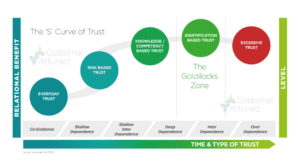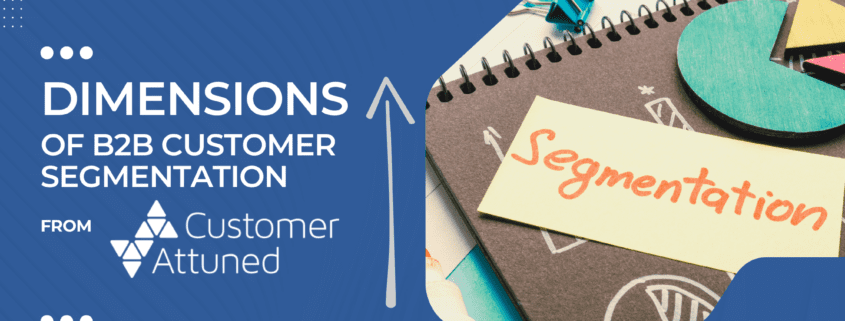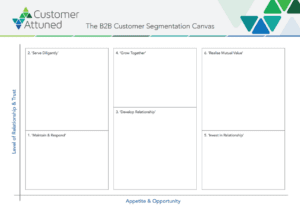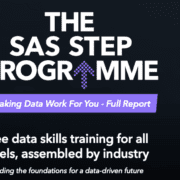The Dimensions of the Customer Segmentation Canvas
It’s the two dimensions of the B2B Customer Segmentation Canvas that make it special as a tool within organisations. These dimensions are different from conventional segmentation analysis and are, we think, quite exciting for marketing, sales and customer service teams. In this post, Paul Cranston explores why the level of relationship and the depth of trust are used for the vertical axis and why appetite and opportunity form the horizontal axis of the canvas.
The Customer Segmentation Canvas exists as a framework to position customers into easily manageable groupings with clear mandates for objectives. It can be used to position one customer or customers at scale using a range of data and insights making it a customer centric approach.
The Vertical Axis: The level of Relationship and Depth of Trust
 Dr Mark Hollyoake’s research into B2B Trust resulted in the creation of new concepts and models and earned him a PhD. One of these models, The S-Curve of Trust, is what we are basing the Y-Axis on. We know that the more trust that resides in a relationship, the more ability there is for companies to know each other’s needs and challenges and the more willingness to share in the creation of new solutions. Two companies do not get to this point immediately or by accident! There is a process where trust is earned. This process is what defines a customer’s position up the canvas; the greater the trust in the relationship, the higher up the axis the customer resides.
Dr Mark Hollyoake’s research into B2B Trust resulted in the creation of new concepts and models and earned him a PhD. One of these models, The S-Curve of Trust, is what we are basing the Y-Axis on. We know that the more trust that resides in a relationship, the more ability there is for companies to know each other’s needs and challenges and the more willingness to share in the creation of new solutions. Two companies do not get to this point immediately or by accident! There is a process where trust is earned. This process is what defines a customer’s position up the canvas; the greater the trust in the relationship, the higher up the axis the customer resides.
Therefore, customers shown at the base of the canvas, in Segments 1, 3 and 5, do not have much trust with the supplier, or their relationship is at an early stage. As the customer uses the products or services supplied, the relationship develops.
This can be achieved through a range of deliberate activities such as marketing, customer success engagement and, as one participant at a recent discussion commented “somewhat ironically, you can gain more trust with customers that have experienced an issue when they witness the way that you resolve their problem.”
The Horizontal Axis: The Appetite and Opportunity for a Relationship
Traditional segmentation approaches might look at industry, sector or even technology deployed, instead, the second dimension of the Customer Segmentation Canvas is focused on the customer ability and desire for a deeper relationship. It’s all very well thinking that just because an organisation has a billion pound turnover that they *could* buy your product, but that doesn’t mean that they either want or need it!
Including the appetite and opportunity for a relationship in segmentation ensures that effort is exerted on accounts that are more likely to convert than those that aren’t. For example, if the organisation is a customer because the service is required for regulatory purposes, it is possible that the customer has no desire or appetite for your other products.
Or consider the company that loves your product or service, in fact they promote their use of it with you through a case study. They would invest in more, however, there is only one product that suits their need, your other product is designed for a different market. In this case, there is no opportunity for them to buy more.
Contrast this with the scenario that you produce 5 products that can be purchased by all companies within this one sector and this particular customer only has 2 of them and loves the products, they are delivering on all the promises expressed during the sales process. There is both appetite and opportunity for a deeper relationship.
There are two critical feeds into placing the customer on this axis; are there more products available that suit this customer type and do they want it?!
The first answer can be answered internally. The second, however, demands a conversation with the customer, which is the subject of other Customer Attuned posts.
Benefits of Using these Dimensions
What these two dimensions deliver through the B2B Customer Segmentation Canvas is the placement of customers (and the profiles of prospective customers) in a way that helps you build and maintain relationships at the appropriate levels, in the appropriate ways with the appropriate resources.
Customer Attuned helps organisations develop their Customer Strategies and uses the Customer Segmentation Canvas as a tool as a part of this service. If you need assistance with the use of this framework, or have undertaken a segmentation exercise and need help in moving forward with it, please contact us.
Download the workbook and blank canvas here by clicking on the icons below:
- Customer Segmentation for Sales - July 17, 2024
- The B2B Customer Segmentation Canvas for Marketers - June 12, 2024
- The Dimensions of the Customer Segmentation Canvas - April 10, 2024







